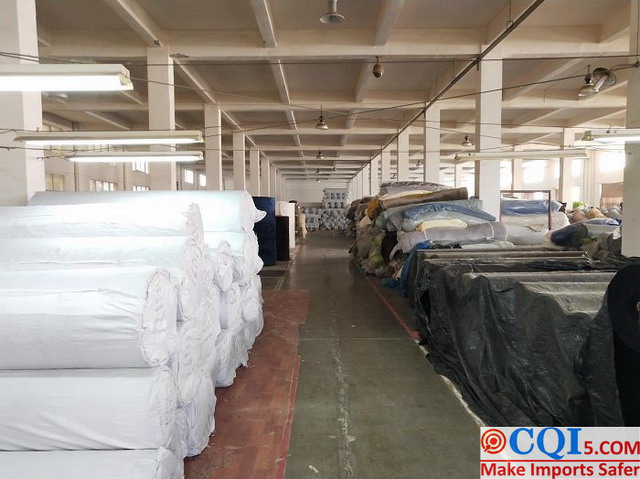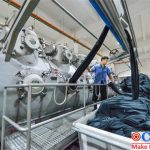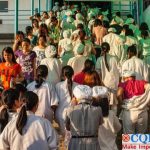Major Textile Industry Clusters in China Share
In the China home textile industry, places like Haimen, Yuhang and Samsung are always mentioned. But only the industry insiders know, next, we will slowly explain each cluster of Chinese home textiles and the main production area of home textiles .
Haimen ,Jiangsu Province-China Textile Industry Clusters
Jiangsu Haimen stacked stone bridge home textile is located in Haimen, Jiangsu Province, China. created on May 15, 2004, covers an area of 50,000 square meters, mainly consists of: home textile display center, R & D center, conference center and supporting facilities home textile trading market.
At present, stacked stone bridge has become the national home textile series products production base, sales place and logistics center, mainly reflected in the following aspects.
Production scale. Stacked stone bridge is located in the town of three stars that has home textile industrial enterprises 150, individual processing households 3078. Among them, 60 enterprises above the scale, 10 million U.S. dollars enterprise 3, plus the surrounding township home textile industrial enterprises, the total number of more than a thousand,with division of labor socialization. From raw material procurement, production, processing to product sales, a professional division of labor has been formed. Even in production and processing, one household only does one of the processes.
Intelligent equipment. Home textile products such as pillowcases and bedspreads were embroidered by hand at first, and then embroidered on sewing machines. Since 1990s, electric embroidery machine has been widely used for embroidery. Now it has developed in the direction of computerization and automation.
The home textile industry has more than 8,000 computerized embroidery machines, more than 3,000 computerized multi-needle quilting machines, more than 25,000 industrial sewing machines, 35 spray adhesive cotton production lines and more than 2,800 other related equipment, with a total equipment value of more than 200 million U.S. dollars.
Product serialization. At the beginning, the home textile industry of Stacked Stone Bridge mainly produced pillow cases and TV sets and other home appliance covers. Later, bed covers, curtains, cloud silk quilts, sofa seat cushions, backrests, etc. were developed. 
Jiangzao, Tongzhou, Jiangsu-China Textile Industry Clusters
The home textile industry in Jiangzao Town, Jiangsu Province started in the 1980s, starting from the initial one-family handmade production, which has lasted for decades. After the Chinese government at all levels vigorously implement structural adjustment and technological transformation, it gradually formed a set of spinning, weaving, dyeing, printing, embroidery, machine embroidery, quilting, production, packaging in one of the Chinese home textile industry system.
There are 918 industrial enterprises in the town, including 809 enterprises in home textile industry, accounting for 88.1%. The annual home textile enterprises completed industrial output value of 750 million U.S. dollars, achieved sales revenue of 7. 600 million U.S. dollars, creating profits of 37.7 million U.S. dollars, accounting for 91.2%, 92.7% and 94.2% of the town’s total economic output, export earnings of more than 11.9 million U.S. dollars, export delivery value of 163 million U.S. dollars, accounting for 83.5% and 86.4% of the town, respectively.
In addition, the town also concentrated on strengthening everyone’s textile capacity and continuously improving independent research and development capabilities. Through the wide admission of talents and increasing the introduction of technology, we hope to produce different types of high-grade fabrics, including various industrial fabrics and some high-grade branded apparel fabrics, as well as branded home textile products, including bed series, home furnishing and textile products.
At the same time, we continue to introduce advanced home textile technology and equipment from outside, so that we can make a complete set of various kinds of equipment such as computerized embroidery machines, computerized multi-needle quilting machines, industrial sewing machines, non-woven fabrics, printing and dyeing production lines. Secondly, it is equipped with a complete production, marketing and transportation system. From the provision of raw and auxiliary materials to the production, processing and packaging of each link, until entering the market, a highly flexible “one-town” supporting professional production, marketing and transportation collaboration network is formed.
Xiqiao, Guangdong-China Textile Industry Clusters
Guangdong Xiqiao Light Textile Market, located in the middle and senior fabric wholesale, is one of the three largest textile wholesale markets in China. It covers an area of 540,000 square meters and has 3,000 stores, with business areas for garment fabrics, denim, decorative fabrics, raw materials, accessories and logistics center. The market covers an area of 540,000 square meters, with more than 3,000 stores and large trading areas for: textile raw materials, garment fabrics, decorative fabrics, bedding, denim cotton fabrics, textile machinery, cloth retail and curtain processing.
Wendeng, Shandong-China Textile Industry Clusters
According to Chinese history, from the late 19th century, handicrafts were widely spread in Wendeng folk; by the 1970s and 1980s, craft home textiles entered a period of prosperous development in Wendeng, with 100,000 embroiderers in the city engaged in craft home textiles. Wendeng’s home textile industry started from this embroidery needle. After twenty years of technical innovation, Wendeng was named “China Craft and Home Textile City” in early summer of 2004.
In 2009, there are more than 4,000 home textile enterprises and various supporting enterprises in Wendeng, employing 138,000 people, and the annual output value accounts for more than 25% of the total industrial output value of Wendeng, with more than 80% of villages having embroidery processing points and 45% of rural families benefiting from this industry.
Wudi, Shandong-China Textile Industry Clusters
The general idea of the development of home textile industry in Wudi County, Shandong Province is to focus on the goal of building a strong county for home textile in China, highlighting the characteristics, relying on science and technology, taking extraordinary measures and strengthening policy support. All efforts are made to extend the industrial chain, create scale advantages, and enhance the competitive strength and economic benefits of the home textile industry.
Xucun, Haining, Zhejiang-China Textile Industry Clusters
Xucun Town, a modern industrial and trade town with home textile industry as the leading industry. After more than 20 years of development, XuCun home textile industry has built up a perfect home textile combination supporting system of raw material supply, weaving, dyeing and finishing, testing, product development and sales.
There are 325 company-type home textile enterprises and more than 6,000 individual enterprises with specialized division of labor, including 68 enterprises with annual sales revenue of more than 5 million yuan, 2 enterprises with more than 100 million yuan, 29 enterprises with import and export rights, and 11 excellent home textile export enterprises in China.
China Textile Industry
There are 41,000 employees in the industry and more than 7,000 marketing personnel all over China. We have more than 30,000 sets of various types of looms and machines and equipment for paper production, printing and dyeing, and about 5,700 sets of advanced equipment. We mainly produce and sell high, medium and low grade curtain fabrics, sofa sheets, bedding, finished curtains, carpets, tablecloths, table rugs, pillows, cushions, shower curtains, etc.
CQI5 is committed to providing importers worldwide with product quality inspection services that far exceed those of our peers. If you are planning to import or have imported from China or Southeast Asian countries, please contact us cs’@’cqipro.com to learn more about how we can make your imports safer.
Disclaimer:
CQI5 article information from the Internet and contributions, the copyright of which belongs to the original author, and only represents the views of the original author. This website is only responsible for sorting out, typesetting and editing the articles, reproduced for the purpose of spreading more information, does not imply that it endorses its views or proves the truthfulness, completeness and accuracy of its content, and therefore does not assume any legal responsibility.
The information contained in this article is for reference only and is not intended as direct advice for decision-making.
If we inadvertently violate your copyright, please inform us, after verification, we will immediately correct or delete the content according to the requirements of the copyright holder, thank you! Contact, email: copyright@cqipro.com
This website has the final right to interpret this statement.
Welcome to reprint, please be sure to keep information complete.





